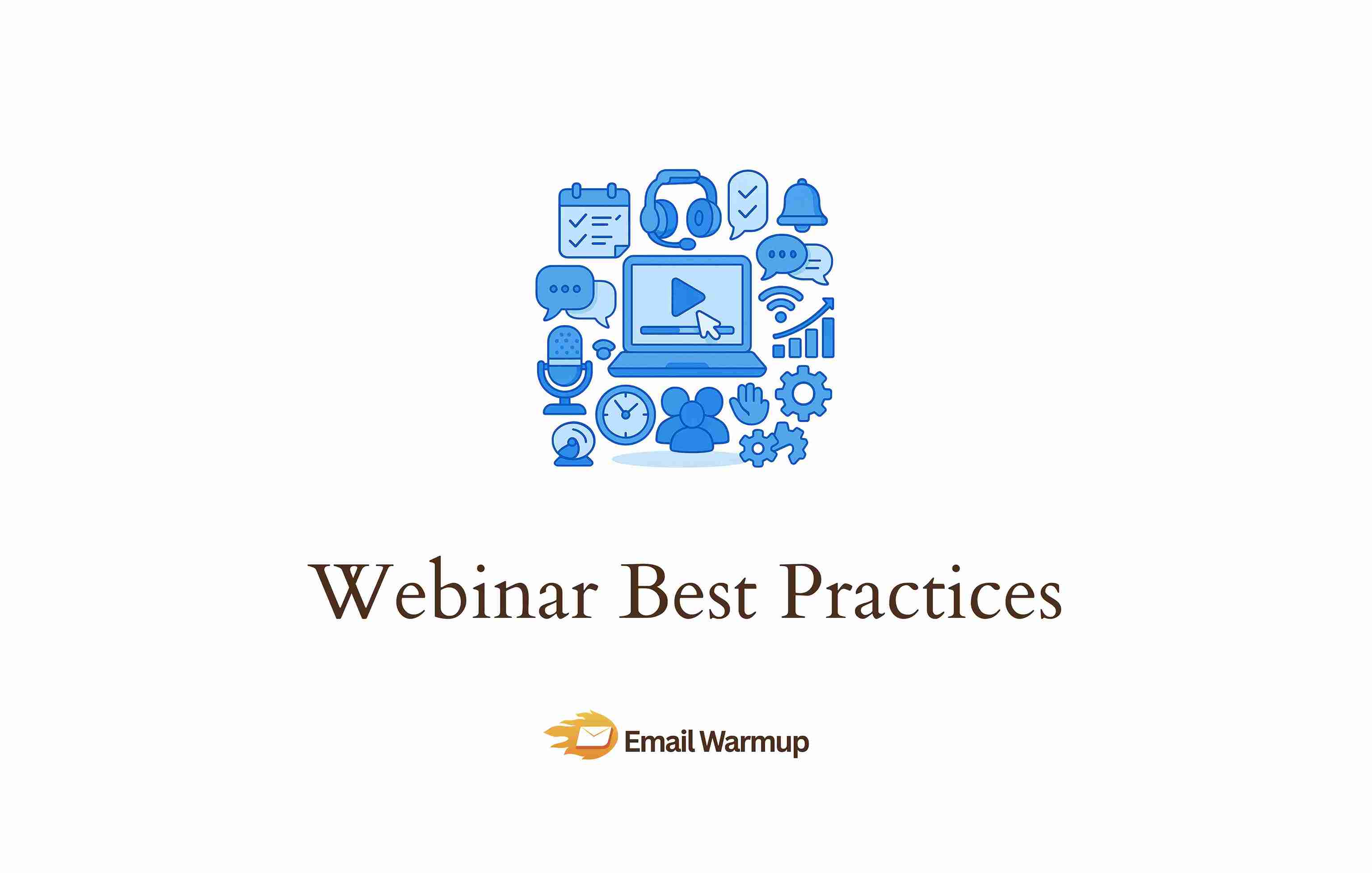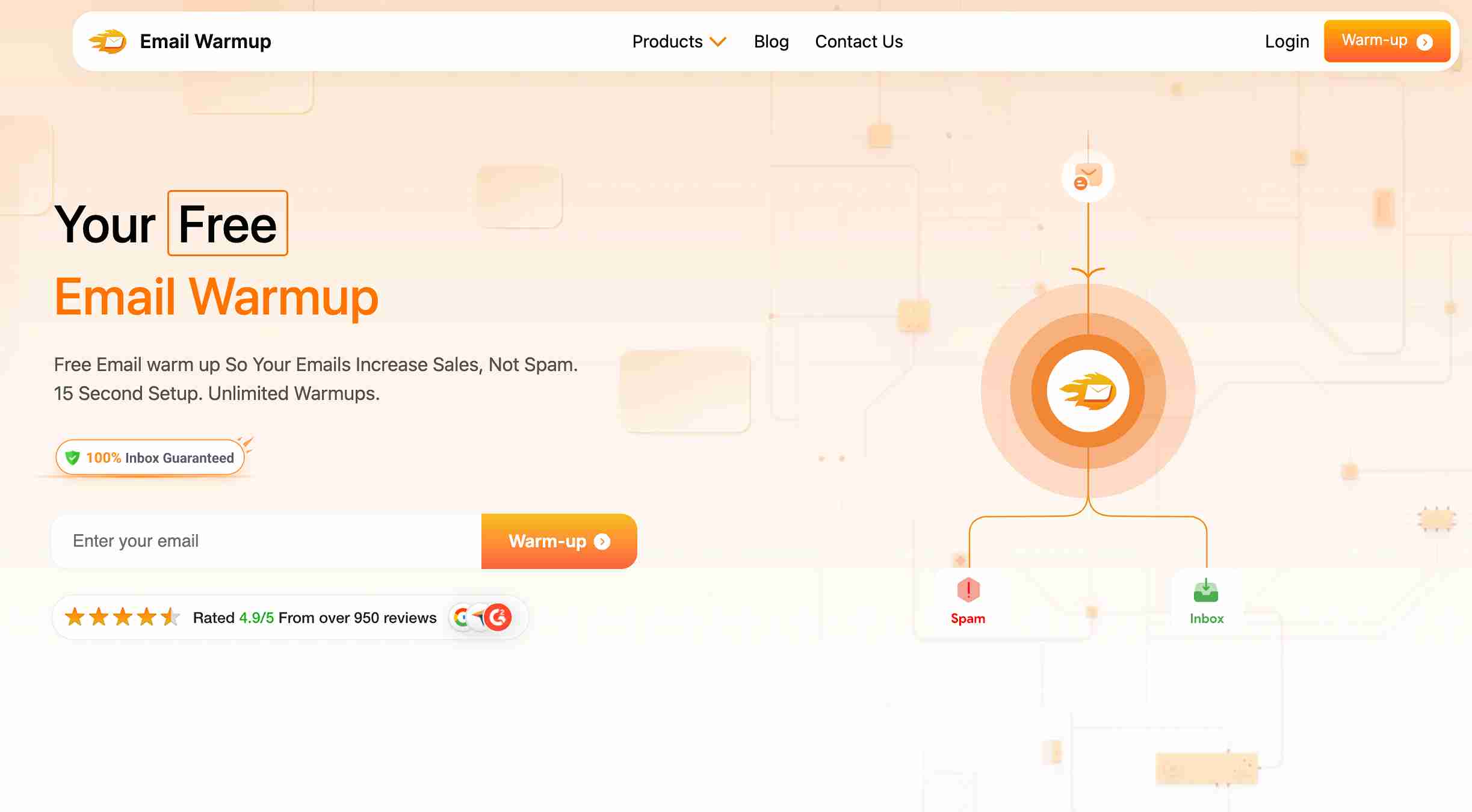
Your boss is asking why the pipeline didn’t move, and you’re questioning whether webinars still work.
The budget you burned, the speakers you coordinated, the emails you crafted — all for a 24% show rate and conversations that went nowhere.
To make a webinar work, you need to have a systematic approach that treats webinars as pipeline machines, not one-off events.
In this guide, I’ve accumulated all webinar best practices to drive registrations, attendance, and meetings:
- How to plan webinars people want to attend (topic selection, speaker vetting, goal setting)
- Execution strategies for keeping attendees engaged throughout the session
- Measurement frameworks for proving ROI and improving future events
- Promotion tactics that fill your registration pipeline 4-8 weeks out
- Post-event follow-up that converts engagement into pipeline
Let’s dive in and explore.
TLDR: Quick framework for webinar best practices
Don’t have the time to read the entire piece? Here’s a quick step-by-step guide to webinar best practices:
| Phase | Timeline | Critical actions |
| Planning | 6-8 weeks before | Define goal and audience, select topic, book speakers |
| Promotion setup | 4-6 weeks before | Build a landing page, write email sequences, and set up tracking |
| Active promotion | 3-4 weeks before | Launch campaigns, activate partners, send invitations |
| Pre-event prep | 1-2 weeks before | Rehearse with speakers, test tech, send reminders |
| Live execution | Event day | Run an interactive session, moderate engagement, and record |
| Follow-up | Within 24 hours | Send recordings, segment leads, trigger nurture workflows |
| Analysis | 2-7 days after | Review metrics, gather feedback, repurpose content |
Your webinar follow-up depends on email reputation
You can run a perfect webinar, but if your follow-up emails land in spam, none of it matters.
When you’re sending recordings, resources, and meeting invites to hundreds of registrants, your email deliverability makes or breaks the entire ROI equation.

EmailWarmup.com keeps your follow-up emails out of spam folders and in front of decision-makers. Our platform helps teams running campaigns that need to reach inboxes consistently with:
- Personalized email warmup
- Real-time deliverability monitoring
- Unlimited deliverability consultations
- Email deliverability test and email spam checker
Want to see how our system can work, complementing your webinar best practices?
What makes webinars actually work in 2025?
Webinars work when they’re built on strategic foundations, not optimistic guesses.
The difference between a webinar that generates a qualified pipeline and one that wastes everyone’s time starts with clarity about three things: your goal, your audience, and where they sit in the buying journey.
Success requires reversing the typical approach.
Start with strategy, build content around audience needs, promote relentlessly across channels, execute with production quality, and follow up based on engagement data.
Most teams skip the foundational work and jump straight to picking a date (then wonder why nobody shows up).
How do you plan a webinar that people want to attend?
Planning determines everything downstream. Get this phase wrong and no amount of promotion or polish will save your attendance rate.

Define your goal first
Every webinar needs a specific, measurable objective that dictates your content, targeting, and follow-up.
Write it down: “Generate [specific number] of [qualified leads/meetings/opportunities] from [target audience] by [date].”
Map your goal to the funnel stage. Top-of-funnel focuses on thought leadership (targeting 500 registrations, 40%+ engagement).
Mid-funnel addresses specific challenges (40% attendance, 15% booking demos). The decision stage removes final objections (20 booked meetings from 100 attendees).
Know exactly who you’re talking to
Generic content attracts generic audiences.
You need hyper-specific insights about who you’re serving and what keeps them awake worrying about their job.
Pull CRM reports on your highest-value customers. Analyze job titles, company size, industries, and problems they hired you to solve.
Talk to your sales team (they hear objections daily), your customer success team (they know which features solve urgent problems), and your support team (they field the same frustrated questions repeatedly).
Build a persona document that includes job title, primary responsibilities, KPIs they’re measured on, specific problems they’re trying to solve this quarter, current solutions they’re using (and why those fall short), and common objections when evaluating new vendors.
Pick topics that solve real problems
Your topic is your marketing. A compelling topic does half the promotional work before you send a single email.
Bad topics are broad, vague, or clearly self-serving. “The Future of Marketing” tells me nothing. “Why You Need Our Platform” tells me you’re wasting my time.
Good topics are narrow, specific, and promise actionable insights. “How to reduce CAC by 30% using intent data in Q1 campaigns” tells me exactly what I’ll learn and why it matters.
Find winning topics by analyzing your most-read blog posts, reviewing questions prospects ask during sales calls, monitoring industry conversations on LinkedIn, running polls asking your audience what they want to learn, and examining competitor webinars that generated strong attendance.
Choose and prep your speakers
Knowledge without presentation skills kills engagement. Your speaker needs both subject matter expertise and the ability to hold attention for 45 minutes on a screen.
Vet speakers by watching recordings of their previous talks. Can they tell stories that illustrate their points? Do they vary tone and pace? Do they use slides as visual aids instead of reading bullet points verbatim?
Research by Hovland and Weiss showed that source credibility (expertise and trustworthiness) directly impacts persuasion.
Replace the generic bios with one line that proves competence and one that signals warmth. Instead of “John Smith has 15 years of experience,” try “John helped three Fortune 500 companies cut churn by 40% using the framework you’ll learn today.”
Schedule at least two rehearsals. The first focuses on content and flow, and the second focuses on timing, transitions, and technical execution.
How should you promote your webinar?
Registration numbers depend on promotion intensity and channel mix. You need a coordinated campaign that starts early and builds momentum as the event approaches.
Start 4-8 weeks out
Give yourself enough runway to reach your target audience multiple times across multiple channels. Map out your promotion calendar, working backward from the event date.
Your promotion budget should reflect your registration target. If you need 500 registrations and you’re getting 5% conversion on paid traffic, you need to reach 10,000 people through paid channels alone.
Multi-channel campaigns consistently outperform single-channel approaches:
- Organic and paid social on LinkedIn and Twitter
- Website banners for visitors showing relevant intent signals
- Email marketing to your owned database (segmented by relevance)
- Sales outreach where reps invite prospects they’re actively nurturing
- Partner co-marketing where complementary vendors promote to their lists
Build a registration page that converts
Your landing page either removes friction or creates it.
Structure your page for clarity and speed by prominently displaying a headline that states specific value, date, and time, including speaker names with brief credibility statements, a bullet list of 3-5 particular takeaways, and a registration form that asks only for information you’ll actually use.
Keep your form concise. Research consistently shows shorter forms convert better. Only ask for information you’ll use to segment follow-up or qualify leads (typically name, email, company, title).
On the thank-you page, ask registrants to write an If-Then plan — research by Gollwitzer shows that specifying when, where, and how you’ll do something dramatically increases follow-through.
Studies by Freedman and Fraser show that small initial commitments increase compliance with larger ones later.
Use email as your primary driver
Email remains the highest-converting channel for webinar registrations because your owned database already knows who you are (which removes the biggest barrier to signing up for an hour-long commitment).
Segment your list by engagement level, job title, industry, company size, buying stage, and past webinar attendance patterns.
Write subject lines that communicate specific value.
“Webinar: Marketing Strategies” gets ignored. “How to hit Q1 pipeline targets with 20% less ad spend” gets opened because it promises a specific, desirable outcome.
Plan your email cadence carefully:
- Initial invitation (3-4 weeks before)
- Follow-up to non-opens (2 weeks before)
- Last chance invitation (3-5 days before)
- Reminder to registrants (1 day before)
- Final reminder to registrants (1 hour before)
When you’re sending this many emails to large lists, your sender reputation determines whether they reach inboxes or get filtered to spam. Consider running an email deliverability test on your invitation sequence before launching to your full database.
Turn registrants into attendees
Registration is just the first conversion. Typical show rates range from 30-50% depending on your audience, promotion quality, and how well you remind registrants.
Each reminder should reinforce value and reduce friction.
Don’t just say “reminder: webinar tomorrow.” Say “tomorrow you’ll learn the exact framework we used to reduce churn by 23% last quarter.”
Build anticipation between registration and the event.
Share teaser content on social media. Send a pre-webinar email with a thought-provoking question related to your topic and ask registrants to share their answers.
What does execution look like on the day?
Live delivery separates average webinars from memorable ones. You need flawless technical execution combined with engaging content and continuous interaction.

Technical setup is non-negotiable
Technical failures destroy credibility faster than anything else.
When your audio cuts out or your screen freezes, attendees might assume you’re not professional enough to execute your solution. Research by Newman and Schwarz found that poor audio quality led people to judge both the research and the researcher more negatively.
In virtual court experiments by Bild and colleagues, low audio quality reduced witness credibility, impaired fact recall, and weakened the impact on verdicts.
Invest in proper equipment — a dynamic microphone with an audio interface (never use laptop built-in audio), an HD webcam, a ring light positioned to eliminate shadows, a wired Ethernet connection, a backup internet connection, and a secondary device loaded with your presentation.
Test everything 24 hours before the event. Check audio quality, video resolution, screen sharing, polling functionality, recording settings, and chat features. Run a second test 30 minutes before go-live with your core team.
Start strong and stay interactive
The first 60 seconds determine whether attendees stay engaged or start checking email. You need a hook that makes them feel like showing up was worth their time.
Research on the Peak-End Rule by Kahneman shows that people judge experiences mostly by their peaks and endings, not the average. Put your single biggest “aha” moment within the first 7-10 minutes. Save a second mini-peak for the last 5 minutes.
Open with a surprising statistic that challenges conventional thinking, a provocative question that makes them reconsider their current approach, or a brief story about a customer who faced the exact problem your audience is experiencing. Don’t start with housekeeping or your full bio.
According to ON24’s 2025 Webinar Benchmarks analysis, polling and Q&A consistently drive the highest engagement, and engaged attendees convert at significantly higher rates.

Use interactive features constantly:
- Launch a poll in the first 5 minutes
- Ask attendees to type their biggest challenge in the chat
- Run a quick quiz, pause every 10-15 minutes for questions, and share real-time poll results
Insert 2-3 one-minute retrieval breaks throughout your webinar. Research by Roediger and Karpicke shows that actively recalling information produces superior long-term retention compared to passive re-reading.
Assign a dedicated moderator to manage engagement so your presenter can focus entirely on content delivery. Limit your core content to 40 minutes maximum.
Deliver content that sticks
Design slides that support your points instead of competing for attention:
- Minimal text
- High-quality images
- Consistent branding
- Plenty of white space
- One main idea per slide
- Large fonts (minimum 24pt)
Tell stories that illustrate your frameworks. Case studies and personal experiences make abstract concepts concrete. Vary your pacing and tone to emphasize key points.
According to Hick’s Law and choice overload research by Iyengar and Lepper, decision time grows with the number of options, and too many choices reduce action. Offer one primary CTA (like “Book a consult”) and at most one low-friction alternative.
BJ Fogg’s Behavior Model states that behavior happens when Motivation, Ability, and a Prompt come together at the same time. Place your main CTA during the emotional peak (right after your biggest insight), not only at the end.
What happens after everyone logs off?
Post-event execution determines whether your webinar generates pipeline or just inflates your content library. You need fast, personalized follow-up based on how each person engaged.

Follow up within 24 hours
Speed matters. Research by Oldroyd, McElheran, and Elkington found that contacting leads quickly dramatically improves outcomes.
Studies by InsideSales and MIT quantified the sharp decay in contact and qualification odds as minutes pass after initial interest.
Send different messages to different segments: attendees who stayed the entire session, attendees who dropped off early, and no-shows who registered but never joined.
Your follow-up email to attendees should include a personal thank-you, link to the recording and slides, a brief summary of key takeaways, links to relevant resources, and a clear call-to-action with an easy scheduling link.
Before sending thousands of follow-up emails, make sure they’ll actually reach inboxes. Use an email spam checker to test your follow-up message.
Finding out your carefully crafted follow-up is hitting spam folders after you’ve already sent it to your entire list is an expensive mistake.
Nurture based on engagement
Not everyone who attends is ready to buy immediately.
Segment your attendees based on poll participation, questions asked, chat activity, time spent in session, CTA clicks, and form fills.
High-engagement attendees should get priority sales outreach within 48 hours.
Build automated workflows triggered by webinar attendance: thank you and resources (Day 1), a related case study (Day 3), educational content (Day 7), an invitation to another event (Day 14), and a demo invitation (Day 21).
Sync your webinar platform data with your CRM so sales and marketing teams have context for every interaction.
Repurpose everything
Your 60-minute webinar contains enough raw material to fuel weeks of content across multiple channels.
Turn your recording into a blog post summarizing key frameworks, social media posts with quotes and statistics, short video clips (2-3 minutes) highlighting specific topics, an infographic visualizing your main framework, a slide deck for standalone download, an email course breaking down concepts, and an updated evergreen version for on-demand viewing.
Use AI transcription tools to generate accurate text from your recording.
Extract 2-3 minute clips highlighting your best moments. Create an on-demand version of high-performing webinars by removing time-sensitive references.
Measure what matters
Track these metrics for every webinar: registration count, registration-to-attendance rate (target 30-50%), average watch time, poll participation rate, questions asked, CTA click rate, lead conversion rate, and no-show watch rate.
The engagement and conversion metrics vary significantly by industry, audience maturity, and offer type. Start by establishing your own baseline, then work to improve against your previous results.
Survey attendees immediately after the event.
Ask what was most valuable, what could have been better, what topics they’d like to see covered next, and how likely they are to recommend your webinars.
Share results with stakeholders within a week — proving ROI keeps your webinar program funded and supported.
What are the common mistakes that kill webinar ROI?
You can do everything right and still sabotage results with a few critical mistakes:
- Skipping rehearsals
- Failing to provide recording access to no-shows
- Asking for information you won’t use on registration forms
- Ending without a clear next step, sending a generic follow-up to everyone
- Choosing convenient times instead of testing what works for your audience
- Talking to attendees instead of creating interactive experiences
- Promoting too late (start 4-6 weeks out, not 2 weeks)
- Not repurposing content
- Ignoring metrics
According to ON24’s 2025 platform-wide benchmarks, Tuesday through Thursday at 11 AM or 2 PM ET consistently show the highest attendance rates for many B2B audiences.
Most teams also underestimate how much promotional intensity they need. If you send two emails and post twice on LinkedIn, you haven’t promoted enough.
Frequently asked questions
Here are some commonly asked questions about webinar best practices:
For small teams, Demio and Livestorm offer the right balance of features and simplicity. Both handle automated reminders, integrate with major CRMs, and offer on-demand capabilities. Zoom Webinars works if you’re already using Zoom for meetings (it integrates natively with HubSpot, Salesforce, and Marketo). Avoid platforms that require dedicated admins or complex setup.
Run one live session at a time that works for your largest audience segment (usually 11 AM or 2 PM ET for US-focused B2B). Make the recording available within 2 hours and promote it heavily to non-attendees in other regions. Many platforms now offer simulated live replays that feel more engaging than on-demand recordings.
Platform subscriptions run $200-$500/month ($2,400-$6,000/year). Promotional ad spend varies — some teams spend $500-$1,500 per webinar ($6,000-$18,000/year), while others rely primarily on organic channels. Production costs (equipment, design, video editing) add another $3,000-$6,000 annually for in-house programs. Start by mapping your registration goals to determine required promotional spend.
Minimum three roles: host/presenter, moderator, and technical support. One person can double up on roles for smaller events, but the host should never moderate their own session. For enterprise programs running weekly webinars, build a team of 5-7, including a program manager, a content creator, a promotional specialist, a production coordinator, and dedicated moderators.
Give them a structured interview format instead of a presentation. You act as the host, asking prepared questions, and they answer naturally based on their expertise. Share 10-12 questions 48 hours before, run a 20-minute rehearsal to practice pacing, and you’re done. This format feels conversational and requires minimal prep.
Your CTA is probably disconnected from your content or asks for too big a commitment. If you taught a framework about email deliverability and your CTA is “buy our enterprise plan,” the gap is too wide. Instead, offer “Book a 15-minute deliverability audit where we’ll analyze your current setup using the framework we just covered.” Also, check whether your sales team is actually reaching out to engaged attendees within 24-48 hours (speed matters significantly).
